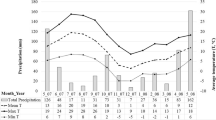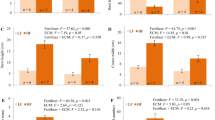Abstract
Impacts of nursery short-day treatments on the survival, growth and needle damage of about 5,000 1 + 0 container white spruce (Picea glauca [Moench] Voss) seedlings from a single seedlot were studied for two growing seasons following planting on July 22, 1999 at four boreal reforestation sites in Northern Alberta, Canada of varying soil texture, drainage, aspect, slope, and slope position. Each site was separated into two areas that were site-prepared by either ripping or mounding. When seedlings reached a height of about 20 cm under normal greenhouse growth conditions, the seedlings from different germination dates over a 7-week period were exposed to one of five different conditioning treatments (T), mainly through varying the duration of 12-h short-day exposure to 0 (T0), 3 (T3), 7 (T7), 10 (T10), or 15 (T15) days followed by different periods of reduced N supply. N-reduction produced few differences in needle nutrient concentrations and so was not considered a likely cause of differences in field performance. The treatments progressively (from T0 to T15) increased tolerance to drought and frost, and resulted in a similar seedling size for T3, T7 and T10 (planting height of 21 cm and ground diameter of 2.9 mm) although T0 seedlings were smaller (20 cm) and T15 taller (24 cm). The weather in 1999 was dry, particularly in the weeks immediately before and after planting, but relatively moist and favorable in 2000 and 2001 apart from one major frost event (−7°C) in May 2000. Survival, growth and needle damage varied substantially among sites and short-day treatments, and the treatment differences were largely consistent across the four sites. In general the growth was better on the ripped than on the mounded areas. Seedlings in T7 (intermediate tolerance) survived and grew best in the first year but T0 (actively growing) did best during the second year. After 2 years, no differences were observed among T0, T3 and T7 in mortality (18%) and total height growth (15 cm). However, T10 and T15 had higher mortality (24 and 43%), and lower height growth (12 and 10 cm, respectively). The percentage of seedlings showing very severe needle damage after 2 years increased from T0 through T15 (14–33%). New root egress in the field also differed significantly among treatments and was positively and highly correlated with survival rate and growth. These results suggest that a longer short-day regime, as in T10 or T15, may be counterproductive and a shorter regime may be more effective in improving the performance of summer-planted white spruce seedlings.








Similar content being viewed by others
References
Alberta Environmental Protection (1996) Pre-harvest ecological assessment handbook. Alberta Environmental Protection, Pub. No. 96 (Feb 1996), 36 pp
Bigras FJ, Gonzales A, D’Aoust AL, Hébert C (1996) Frost hardiness, bud phenology and growth of containerized Picea mariana seedlings grown at three nitrogen levels and three temperature regimes. New For 12:243–259
Blake TJ, Sutton RF (1988) Stomatal responses; the key to adaptation in newly planted jack pine and black spruce. Plant Physiol (Life Sci Adv) 7:125–130
Blum A (1988) Plant breeding for stress environments. CRC Press, Boca Raton, 208 pp
Coursolle C, Bigras FJ, Margolis HA, Hébert C (1998) Growth and hardening of four provenances of containerized white spruce (Picea glauca [Moench] Voss) in response to the duration of 16 h long-night treatments. New For 16:155–166
Day TA, DeLucia EH, Smith WK (1990) Effect of soil temperature on stem sap flow, shoot gas exchange and water potential of Picea engelmannii (Parry) during snow melt. Oecologia 84:474–481
Folk RS, Grossnickle SC (1997) Determining field performance potential with the use of limiting environmental conditions. New For 19:121–138
Fisher RF, Binkley D (2000) Ecology and management of forest soils, 3rd edn. John Wiley & Sons, New York, 489 pp
Geiger R (1980) The climate near the ground. Harvard University Press, Cambridge, 626 pp
Grossnickle SC (2000) Ecophysiology of northern spruce species—the performance of planted seedlings. NRC Research Press, Ottawa, 407 pp
Hahn PF, Smith AJ (1983) Douglas-fir planting stock performance—comparison after the third growing season. Tree Planters’ Notes 34:33–39
Hawkins CDB, Draper DA (1991) Effects of blackout on British Columbia spruce seedlots at Red Rock Research Station. Canada. British Columbia FRDA Res Rep 170, BC Ministry of Forests, Victoria, 58 pp
Hawkins CDB, Shewan KB (2000) Frost hardiness, height, and dormancy of 15 short-day, nursery-treated interior spruce seed lots. Can J For Res 30:1096–1105
Hawkins CDB, Eastham AW, Story TL, Eng RYN, Draper DA (1996) The effect of nursery blackout application on Sitka spruce seedlings. Can J For Res 26:2201–2213
Helenius P, Luoranen J, Rikala R (2005) Physiological and morphological responses of dormant and growing Norway spruce container seedlings to drought after planting. Ann For Sci 62:201–207
Kaufmann MR (1975) Leaf water stress in Engelmann spruce: influence of the root and shoot environments. Plant Physiol 58:841–844
Kozlowski TT, Pallardy SG (1997) Physiology of woody plants, 2nd edn. Academic Press, New York, 411 pp
Kozlowski TT, Kramer PJ, Pallardy SG (1991) The physiological ecology of woody plants. Academic Press, New York, 657 pp
Krasowski MJ, Letchford T, Eastham AM (1993) Growth of short-day treated spruce seedlings planted throughout British Columbia. FRDA Rep 209, Forestry Canada and British Columbia Ministry of Forests, Victoria, 39 pp
Landsberg JJ (1986) Physiological ecology of forest production. Academic Press, New York, 198 pp
Larcher W (1980) Physiological plant ecology, 2nd edn. Springer-Verlag, New York, 513 pp
Levitt J (1980) Responses of plants to environmental stresses. Vol. II: water, radiation, salt and other stresses. Academic Press, New York, 607 pp
Luoranen J (2000) Control of growth and frost hardening of silver birch container seedlings: growth retardants, short day treatment and summer planting. The Finish Forest Research Institute, Research Paper 777, 167 pp
Mattsson A (1997) Predicting field performance using seedling quality assessment. New For 13:227–252
Miller DR, Vavrina CA, Christensen TW (1980) Measurement of sap flow and transpiration in ring-porous oaks using heat pulse velocity technique. For Sci 26:485–494
Mitchell WK, Dunsworth G, Simpson DG, Vyse A (1995) Planting and seeding, pp 235–253. In: Lavender DP, Parish R, Johnson CM, Montgomery G, Vyse A, Willis RA, Winston D (eds) Regenerating British Columbia’s forests. UBC Press, Vancouver, 372 pp
Paterson J (1997) Growing environment and container type influence field performance of black spruce container stock. New For 13:329–339
Paterson J, DeYoe D, Millson S, Galloway R (2001) Handling and planting of seedlings, pp 325–341. In: Wagner RG, Colombo SJ (eds) Regenerating the Canadian forest—principles and practice for Ontario. Fitzhenry & Whiteside Ltd., Markham, 650 pp
Philipson JJ (1988) Root growth in Sitka spruce and Douglas-fir transplants: dependence on the shoot and stored carbohydrates. Tree Physiol 4:101–108
Revel J, Lavender DP, Charleson L (1990) Summer planting of white spruce and lodgepole pine seedlings. FRDA Report 145, Forestry Canada and British Columbia Ministry of Forests, Victoria, 14 pp
Ritchie GA, Dunlap JR (1980) Root growth potential: its development and expression in forest tree seedlings. NZ J For Sci 10:218–248
Rose R, Gleason JF, Atkinson M (1993) Morphological and water-stress characteristics of three Douglas-fir stocktypes in relation to seedling performance under different soil moisture conditions. New For 7:1–7
Spittlehouse DL, Stathers RJ (1990) Seedling microclimate. FRDA Rep 65. Forestry Canada and British Columbia Ministry of Forests, Victoria, 28 pp
Simpson DG, Ritchie GA (1997) Does RGP predict field performance? A debate. New For 13:253–277
South DB, Mason WL (1993) Influence of differences in planting stock size on early height growth of Sitka Spruce. Forestry 66:83–96
Sutton RF (1980) Planting stock quality, root growth capacity and field performance of three boreal conifers. NZ J For Sci 10:54–71
Sutton RF (1990) Root growth capacity in coniferous forest trees. HortScience 25:259–266
Tan W (1992) Drought tolerance and growth in black spruce (Picea mariana). PhD thesis, University of Toronto, Toronto, 165 pp
Tan W (2007) Impacts of nursery cultural treatments on stress tolerance in 1 + 0 container white spruce (Picea glauca [Moench] Voss) seedlings for summer planting. New For 33:93–107
van den Driessche R (1987) Importance of current photosynthate to new root growth in planted conifer seedlings. Can J For Res 17:776–782
Van Wagner CE, Pickett TL (1984) Equations and Fortran program for the Canadian Forest Fire Weather Index System. Canadian Forest Service, Revision of Info Rep PS-X-58
Weimer RC (1993) Statistics, 2nd edn. Wm. C. Brown Publishers, Belmont, 777 pp
Acknowledgement
Financial support for the project was provided by Manning Diversified Forest Products Research Trust Fund. Grande Prairie Regional College provided in-kind support. Technical assistance from Tyler Stone, Tan’s family (Yueqing, Pearl and Andy), Blanton’s family (Sherry, Sarah, Tim and Jessie), and the staff of the Woodlands Department at Manning Diversified Forest Products are acknowledged. Critical reviews and comments from Drs. Roy Sutton and Albert Sproule and three anonymous reviewers on earlier drafts are greatly appreciated.
Author information
Authors and Affiliations
Corresponding author
Rights and permissions
About this article
Cite this article
Tan, W., Blanton, S. & Bielech, J.P. Summer planting performance of white spruce 1 + 0 container seedlings affected by nursery short-day treatment. New Forests 35, 187–205 (2008). https://doi.org/10.1007/s11056-007-9071-6
Received:
Accepted:
Published:
Issue Date:
DOI: https://doi.org/10.1007/s11056-007-9071-6




